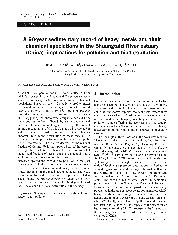摘要
Two parallel sediment cores collected from tidal flat located in the Shuangtaizi River estuary were analyzed for heavy metal concentrations and chemical speciations. Based on the Cs-137 activity profile, mean sedimentation rate at the sampling site during the past 50 years was estimated to be 1.3 cm center dot a(-1). Correlation analyses show that almost all the metals are associated with each other, suggesting that these metals might be derived from same sources and/or affected by same geochemical processes. Influence of total organic carbon (TOC) content on the concentrations of Cr, Ni, Cu and Cd is evident. Silt and clay contents, instead of sand content, play an important role in the distribution of these metals. The dominant binding phases for most of the metals (except for Cd) are the residual. The relative decrease of the residual fraction of Cd and Pb in the upper 66 cm of the core is striking. The distribution of chemical fraction confirms that the residual fractions of these metals have a natural origin, while only the non-residual fractions of Cd and Pb increased upward the core due to pollution in the past five decades. Pollution assessment on these heavy metals based on Index of Geoaccumulation (I (geo)) also demonstrates that most of the metals are unpolluted. The weak pollution as observed in the sediments is perhaps related to a local plant, the Suaeda heteroptera Kitag, which may have played a significant role in the biodegradation of these metals and the metal distribution in the estuary.
- 出版日期2011-9
- 单位中国地质大学(北京)
